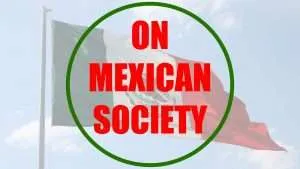Holidays tend to be a time where people interact with one another, which makes it a great time to make sociological observations. We can easily find sociological analyses of Mexican holidays such as Día de Muertos, but what about Day of the Virgin or Día de la Virgen?
Sociology of Day of the Virgin and Technology
According to sociologist Christine Hine, digital technologies have become so embedded and embodied in our daily activities that sometimes we do not perceive them (Hine, 2015). With digital interfaces we create in performative terms spaces and situations where we can celebrate interaction rituals that charge us emotionally (Alexander, 2011), strengthen those ties of solidarity that we have neglected with the confinement.
This piece will deal with the celebration of the Día de la Virgen de Guadalupe in Mexico. It is traditionally a religious ritual that gathers millions of people on December 12th in the Basilica of Guadalupe.
Sociology of Day of the Virgin
Faced with the risk of increasing infections, the Mexican authorities and the Catholic Church decided to cancel the processions to the sacred space. Broadcasts were made at various interfaces of the media ecosystem (Vaidhyanathan, 2018) so that people were part of the ritual from a distance.
We will see how the ritual was lived and the usefulness of digital technologies to replace face-to-face interactions.
The Virgin of Guadalupe as a symbol
It is estimated that around 80% of the Mexican population currently defines itself as a practitioner of the Catholic religion. The “Virgen Morena” or “Virgen de Guadalupe” is not only a religious figure for many Mexicans, it is also considered a national symbol.
Officially the cult of the Virgin began with the construction of the Basilica of Guadalupe in 1709. But the religious cult at that site dates back to pre-Columbian times with Tonantzin. According to Spanish chronicles, the local inhabitants did not go to the churches dedicated to the Virgin, they preferred to go to the Tepeyac hill to worship the mother goddess (Licona, 2005).
People traveled great distances to visit the deity even if they had other religious centers nearby. Therefore, the Spanish decided to destroy the temple and build a new one. They created an account of miraculous events known in Nahuatl as Nican Mopohua to reinforce the new cult of the Virgin.
What does the Virgin of Guadalupe Symbolize?
Product of the syncretism between local and Catholic beliefs, the Virgin of Guadalupe is associated with miracles and hope. Intermediary between God and humanity, people come to this figure for her mercy and compassion. As a mother, she is considered simultaneously protective and one who relieves burdens (Fernández, 2000).
Her faithful make a pact with her which they call “manda” In exchange for divine intervention, people promise to visit her in her temple and leave offerings. To show her devotion or in gratitude for her intervention, some believers perform penances such as going on their knees to the holy site.
Day of the Virgin is the Most Important Religious Celebration in Mexico
The day of the Virgin is considered the most important religious celebration in Mexico. The ritual around the Virgin begins in some places from mid-November, through prayers in homes and visits to local temples. From the first days of December, shops appear around Catholic temples, as the day approaches, these pilgrimages intensify in activity.
Although most people decide to celebrate the day in their communities of origin, each year millions of Mexicans travel to the Basilica to be present at the celebrations and bring offerings. It is estimated that annually between 7 and 9 million people from all over the country converge in the sacred space.
As midnight approaches on the 12th, the atmosphere becomes more cheerful: “Las mañanitas” are sung and the figure of the Virgin is crowned. After that a solemn ceremony is held. Every year this event is covered on television, so that people who cannot be there can see the event.
At morning the popular neighborhoods and towns are filled with colors, flavors and sounds: Fairs and dances are organized. Decorated altars with flowers and candles are put up in honor of the Virgin. Everywhere there is jubilation, people leave their homes and congregate around churches and public squares to celebrate the so-called “Madre de México”.
The ceremony and the pandemic
Holding the celebration would have involved a massive concentration of people from all over the country in one place, raising the already alarming cases of contagion in the country.
The authorities allowed the faithful to gather during the first days of December, implementing from December 6th a sanitary fence in the Basilica to control access with social distancing measures.
From December 10th to 13th they closed the Basilica to avoid crowds and prevent more people from arriving to celebrate the Virgin. To encourage the faithful to stay home, the pope offered a plenary indulgence to those celebrating digitally.
As mechanisms of remote participation, in each home an altar adorned with flowers, candles and music was requested. The pilgrims were asked to leave candles and flowers to decorate the atrium and the altar of the Basilica.
Television networks covered the mid-night and mid-day ceremonies. As around 90% of the population have access to television, it was the most important means of transmitting the main ceremony remotely, reducing the digital divide.
On social media transmissions and publications were made from the official account of the Basilica @INBGuadalupe. Altars built by the faithful in their homes were shared at these interfaces.
Final Thoughts on Day of the Virgin and Pandemic Measures
Although the believers complied with the extraordinary measures to celebrate their ritual and there were no conflicts between authorities and the faithful, the latter were left with a feeling of emptiness.
The restriction on mobility affected the annual procession that took place throughout the country and the closure of the Basilica generated discomfort by not being present in the sacred place to celebrate the Virgin and fulfill the promises made to the Virgin.
In performative terms, we can speak of a partial emotional charge when the ritual is not fulfilled in its entirety. Despite this, the digital transmission served as an escape valve to release the tension and uncertainty of many people who needed to strengthen ties of solidarity and emotionally charged by the closure of the temple.
In terms of public health, digital interfaces helped reduce contagion without the need for repression by moving much of the interaction to the digital plane. Not everything was perfect in this aspect: the promises and the devotion to the Virgin generated pilgrimages in the days before the closure, increasing the risk of contagion during the trip to the temple and during their stay in it. During the closure, the pilgrims came as far as the authorities allowed or gathered in alternative temples in an attempt to be faithful to the traditional ritual.
The end of the year and social distance
The transfer of popular celebrations to digital spaces is a good way to take advantage of a performance to replace physical co-presence. Let’s cut the chains of contagion and strengthen ties of solidarity with our loved ones through digital interaction.
As sociologists we could contribute in these times of confinement with proposals to maximize interactions in digital spaces, make them more dynamic and attractive for the diverse population groups around the world.
2021 is perceived as a year full of hope to change the situation of 2020. Let´s use our sociological imagination to help realize that desire!

References
- Alexander, Jeffrey (2011). Performance and power, Cambridge, Polity Press, UK.
- Fernández Poncela, Anna M. (2000) “Guadalupanismo género y religiosidad popular”, Casa del Tiempo, septiembre 2000, sección Laberinto, UAM, México, disponible en: http://www.uam.mx/difusion/revista/sep2000/fernandez.html
- Hine, Christine (2015). Ethnography for the internet. Embedded, embodied and everyday, Bloomsbury Publishing Plc, Bloomsbury Academic, UK.
- Licona Valencia, Ernesto (2005). “La celebración de la Virgen de Guadalupe en la Ciudad de Puebla”, Revista de Antropología Experimental, núm. 5 (16), Universidad de Jaén, España.
- Vaidhyanathan Siva (2018). Antisocial media. How Facebook Disconnects Us and Undermines Democracy, Oxford University Press, USA.








